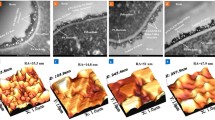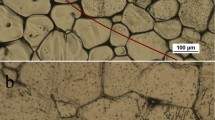Abstract
Improving the productivity without any compromise in selectivity is major challenge in membrane-based separation. Dense reverse osmosis membranes are being used for desalination; however, the first attempt has been made to amalgamate graphene oxide with polysulfone to develop loose composite membranes. With a polymer phase concentration of 21 wt% in dope solution, the membranes are fabricated by phase inversion technique with varying concentration of graphene oxide. The membranes are characterized by various structural and morphological analytical techniques, and the cross-sectional images reveals the porous nature and formation of macrovoids in the substructure of the membrane. This confirms that the incorporation of graphene oxide increases the membrane’s porosity from 2.12% for plain polysulfone membranes to 37.1% for the composite membrane with 3.5 wt% graphene oxide additive. The pure water flux, rejection of divalent and monovalent salt solutions and antifouling studies of the composite membranes were evaluated, and it was noted that the membrane with 2.5 wt% graphene oxide nanosheets demonstrated optimum productivity and selectivity. This membrane provided a flux of 68.96 L/m2h at 5 bar operating pressure and rejection of 71.6% for MgSO4, 56.3% for MgCl2, 39.2% for Na2SO4 and 12.4% for NaCl salts and demonstrated better antifouling properties using bovine serum albumin as a foulant and exhibits 79.5% flux recovery ratio.
Graphical abstract









Similar content being viewed by others
Abbreviations
- AFM:
-
Atomic force microscopy
- ATR:
-
Attenuated total reflectance
- BSA:
-
Bovine serum albumin
- CNT:
-
Carbon nanotube
- DI:
-
Deionized
- DIPS:
-
Diffusion-induced phase separation
- FESEM:
-
Field emission scanning electron microscopy
- FRR:
-
Flux recovery ratio
- FTIR:
-
Fourier transform infra-red
- GO:
-
Graphene oxide
- IEC:
-
Ion exchange capacity
- MMM:
-
Mixed matrix membrane
- NMP:
-
N-Methyl pyrrolidone
- PES:
-
Polyethersulfone
- PSf:
-
Polysulfone
- PVDF:
-
Polyvinylidene fluoride
- PWF:
-
Pure water flux
- RO:
-
Reverse osmosis
- TGA:
-
Thermogravimetric analysis
- TFC:
-
Thin film composite
- UF:
-
Ultrafiltration
- XRD:
-
X-ray diffraction
References
Aba NFD et al (2015) Graphene oxide membranes on ceramic hollow fibers: microstructural stability and nanofiltration performance. J Membr Sci 484:87–94. https://doi.org/10.1016/j.memsci.2015.03.001
Aghigh A et al (2015) Recent advances in utilization of graphene for filtration and desalination of water: a review. Desalination 365:389–397. https://doi.org/10.1016/j.desal.2015.03.024
Alkhouzaam A, Qiblawey H (2021) Novel polysulfone ultrafiltration membranes incorporating polydopamine functionalized graphene oxide with enhanced flux and fouling resistance. J Membr Sci 620:118900. https://doi.org/10.1016/J.MEMSCI.2020.118900
Zheng ALT, Andou Y (2021) Detection and remediation of bisphenol A ( BPA ) using graphene - based materials : mini - review. Int J Environ Sci Technol. https://doi.org/10.1007/s13762-021-03512-x
Ayazi S, Ghorbani M, Abedini R (2019) ‘Chemical Engineering research and design multifunctional composite membranes incorporated by SiO 2 @ CuFe 2 O 4 nanocomposite for high dye removal, antibacterial and antifouling properties. Chem Eng Res Design 169:214–228. https://doi.org/10.1016/j.cherd.2021.03.025
Balapanuru J et al (2019) Desalination properties of a free-standing, partially oxidized few-layer graphene membrane. Desalination 451:72–80. https://doi.org/10.1016/j.desal.2018.08.005
Cay-Durgun P et al (2017) Evaluation of thin film nanocomposite reverse osmosis membranes for long-term brackish water desalination performance. Desalination 404:304–312. https://doi.org/10.1016/j.desal.2016.10.014
Choi H et al (2019) Thin-film composite membranes comprising ultrathin hydrophilic polydopamine interlayer with graphene oxide for forward osmosis. Desalination 449(October 2018):41–49. https://doi.org/10.1016/j.desal.2018.10.012
Daer S et al (2015) Recent applications of nanomaterials in water desalination: a critical review and future opportunities. Desalination 367:37–48. https://doi.org/10.1016/j.desal.2015.03.030
Devrim Y, Albostan A (2016) Graphene-supported platinum catalyst-based membrane electrode assembly for PEM fuel cell’, 45(8), pp 3900–3907. https://doi.org/10.1007/s11664-016-4703-2.
Dimiev AM et al (2014) Mechanism of graphene oxide. ACS Nano 3:3060–3068
Ganesh BM, Isloor AM, Ismail AF (2013) Enhanced hydrophilicity and salt rejection study of graphene oxide-polysulfone mixed matrix membrane. Desalination 313(March):199–207. https://doi.org/10.1016/j.desal.2012.11.037
Gao JGX, Nie MLQ, Liu WPR (2016) Dye adsorption on electrochemical exfoliated graphene oxide nanosheets : pH influence , kinetics and equilibrium in aqueous solution. https://doi.org/10.1007/s13762-016-1143-8
Goh K et al (2015) Graphene oxide as effective selective barriers on a hollow fiber membrane for water treatment process. J Membr Sci 474:244–253. https://doi.org/10.1016/j.memsci.2014.09.057
Hao L, Chi Z, Wang J (2021) Chemical Engineering Research and Design Multilayered surface modification of anion exchange membrane by MoS 2 flakes for improved antifouling performance. Chem Eng Res Design. 171:349–357. https://doi.org/10.1016/j.cherd.2021.05.021
He L et al (2015) Promoted water transport across graphene oxide-poly(amide) thin film composite membranes and their antibacterial activity. Desalination 365:126–135. https://doi.org/10.1016/j.desal.2015.02.032
Hwang T et al (no date) Ultrafiltration using graphene oxide surface-embedded polysulfone membranes, pp. 1–23
Ionita M et al (2015) Composites : Part B synthesis, characterization and in vitro studies of polysulfone / graphene oxide composite membranes. Compos Part B 72:108–115. https://doi.org/10.1016/j.compositesb.2014.11.040
Ismail AF et al (2015) Thin film composite membrane - Recent development and future potential. Desalination 356:140–148. https://doi.org/10.1016/j.desal.2014.10.042
Jhaveri JH, Murthy ZVP (2016) Nanocomposite membranes. Desalin Water Treat 57(55):26803–26819. https://doi.org/10.1080/19443994.2015.1120687
Jin S et al (2015) Effects of reduction methods on the structure and thermal conductivity of free-standing reduced graphene oxide films. Diamond Related Mater. 58:54–61. https://doi.org/10.1016/J.DIAMOND.2015.06.005
Kavitha J et al (2019) Pretreatment processes for seawater reverse osmosis desalination systems—a review. J Water Process Eng. https://doi.org/10.1016/j.jwpe.2019.100926
Lakhe P et al (2020) Graphene oxide synthesis: reaction calorimetry and safety. Ind Eng Chem Res 59(19):9004–9014. https://doi.org/10.1021/acs.iecr.0c00644
Lavanya C et al (2019) Fouling resistant functional blend membrane for removal of organic matter and heavy metal ions. J Environ Manage 232:372–381. https://doi.org/10.1016/j.jenvman.2018.11.093
Lebron YAR et al (2020) Graphene oxide for efficient treatment of real contaminated water by mining tailings: metal adsorption studies to Paraopeba river and risk assessment. Chem Eng J Adv. 2(August):100017. https://doi.org/10.1016/j.ceja.2020.100017
Lee J et al (2013) Graphene oxide nanoplatelets composite membrane with hydrophilic and antifouling properties for wastewater treatment. J Membrane Sci. 448:223–230. https://doi.org/10.1016/j.memsci.2013.08.017
Manikandan GN, Helen KM (2021) Performance studies of GO / PF127 incorporated Polyetherimide Ultrafiltration membranes for the rejection of oil from oil wastewater’. Chem. Eng. Res. Design. 168:214–226. https://doi.org/10.1016/j.cherd.2021.01.019
Miller DJ et al (2017) Surface modification of water purification membranes. Angew Chem Int Ed 56(17):4662–4711. https://doi.org/10.1002/anie.201601509
Misdan N et al (2013) Formation of thin film composite nanofiltration membrane: effect of polysulfone substrate characteristics. Desalination 329:9–18. https://doi.org/10.1016/j.desal.2013.08.021
Nadig AR et al (2021) Impact of graphitic carbon nitride nanosheets in mixed- matrix membranes for removal of heavy metals from water. J Water Process Eng 41(December 2020):1–11. https://doi.org/10.1016/j.jwpe.2021.102026
Naik NS et al (2021) Poly ( ionic liquid ) -Based charge and size selective loose nanofiltration membrane for molecular separation. Chem Eng J 418(January):129372. https://doi.org/10.1016/j.cej.2021.129372
Ng LY et al (2013) Polymeric membranes incorporated with metal/metal oxide nanoparticles: a comprehensive review. Desalination 308:15–33. https://doi.org/10.1016/j.desal.2010.11.033
Ngo THA et al (2016) Surface modification of polyamide thin film composite membrane by coating of titanium dioxide nanoparticles. J Sci Adv Mater Dev 1(4):468–475. https://doi.org/10.1016/j.jsamd.2016.10.002
Padaki M et al (2012) Synthesis, characterization and desalination study of novel PSAB and mPSAB blend membranes with Polysulfone (PSf). Desalination 295:35–42. https://doi.org/10.1016/j.desal.2012.03.014
Parsa SLSAM, Emadzadeh SAD, Lau WJ (2021) Fabrication and evaluation of nanofiltration membrane coated with amino - functionalized graphene oxide for highly efficient heavy metal removal. Int J Environ Sci Technol. https://doi.org/10.1007/s13762-021-03464-2
Paulchamy B, Arthi G, Bd L (2015) A simple approach to stepwise synthesis of graphene oxide, 6(1): 2–5. https://doi.org/10.4172/2157-7439.1000253
Peyki A, Rahimpour A, Jahanshahi M (2015) Preparation and characterization of thin film composite reverse osmosis membranes incorporated with hydrophilic SiO2 nanoparticles. Desalination 368:152–158. https://doi.org/10.1016/j.desal.2014.05.025
Qadir D et al. (2017) Mixed Matrix membranes for water purification applications mixed matrix membranes for water puri fi cation applications, 2119(July). https://doi.org/10.1080/15422119.2016.1196460.
Rezaee R, Nasseri S, Hossein Mahvi A et al. (2015a) Fabrication and characterization of a polysulfone-graphene oxide nanocomposite membrane for arsenate rejection from water. https://doi.org/10.1186/s40201-015-0217-8.
Rezaee R, Nasseri S, Mahvi AH et al (2015b) ‘Fabrication and characterization of a polysulfone-graphene oxide nanocomposite membrane for arsenate rejection from water. J Environ Health Sci Eng 13(1):1–11. https://doi.org/10.1186/s40201-015-0217-8
Sainath K, Modi A, Bellare J (2021) CO2/CH4 mixed gas separation using graphene oxide nanosheets embedded hollow fiber membranes: Evaluating effect of filler concentration on performance. Chem Eng J Adv. https://doi.org/10.1016/j.ceja.2020.100074
Sali S, Mackey HR (2019) Effect of graphene oxide synthesis method on properties and performance of polysulfone-graphene oxide mixed matrix membranes
Sherugar P et al (2021) Fabrication of zinc doped aluminium oxide/polysulfone mixed matrix membranes for enhanced antifouling property and heavy metal removal. Chemosphere 275:130024. https://doi.org/10.1016/J.CHEMOSPHERE.2021.130024
Sonjui T, Promboon A (2014) Sericin recovery from silk cocoon degumming wastewater by a membrane process sericin recovery from silk cocoon degumming wastewater (July 2009)
Subrahmanya TM et al (2019) Blend membranes for removal of toxic metal ions from water. 48254, pp 1–11. https://doi.org/10.1002/app.48254
Sun L, Fugetsu B (2013) Mass production of graphene oxide from expanded graphite. Mater Lett 109:207–210. https://doi.org/10.1016/j.matlet.2013.07.072
Sunil K et al (2018) Al-Ti2O6 a mixed metal oxide based composite membrane: a unique membrane for removal of heavy metals. Chem Eng J 348:678–684. https://doi.org/10.1016/j.cej.2018.05.017
Sunil K et al (2021) Prolific approach for the removal of dyes by an effective interaction with polymer matrix using ultrafiltration membrane. J Environ Chem Eng 9(6):106328. https://doi.org/10.1016/j.jece.2021.106328
Thi H et al. (2019) Preparation and characterization of a hydrophilic polysulfone membrane using graphene oxide, pp 15–20
Vatanpour V et al (2012) TiO 2 embedded mixed matrix PES nanocomposite membranes: influence of different sizes and types of nanoparticles on antifouling and performance. Desalination 292:19–29. https://doi.org/10.1016/j.desal.2012.02.006
Wang X et al (2019) Hydrotalcite/graphene oxide hybrid nanosheets functionalized nanofiltration membrane for desalination. Desalination 451:209–218. https://doi.org/10.1016/j.desal.2017.05.012
Wolf EL (2014) ‘Practical productions of graphene. Supply Cost. https://doi.org/10.1007/978-3-319-03946-6_2
Yadav S et al (2020) Preparation of novel high permeability and antifouling polysulfone-vanillin membrane. Desalination 496(September):114759. https://doi.org/10.1016/j.desal.2020.114759
Yuan Y et al (2017) Enhanced desalination performance of carboxyl functionalized graphene oxide nanofiltration membranes. Desalination 405:29–39. https://doi.org/10.1016/j.desal.2016.11.024
Zareei F et al (2021) Chemical engineering research and design promoting the separation and antifouling properties of polyethersulfone-based nanofiltration membrane by incorporating of cobalt ferrite / activated carbon composite nanoparticles. Inst Chem Eng 169:204–213. https://doi.org/10.1016/j.cherd.2021.03.016
Zhao C et al (2014) Highly effective antifouling performance of PVDF/graphene oxide composite membrane in membrane bioreactor (MBR) system. Desalination 340(1):59–66. https://doi.org/10.1016/j.desal.2014.02.022
Acknowledgements
The author Kavitha J would like to acknowledge the Department of Science and Technology for the financial assistance provided under the WOS – A scheme, SR/WOS-A/ET-169/2016.
Author information
Authors and Affiliations
Contributions
KJ was involved in the conceptualization, methodology, data curation, funding acquisition, writing—original draft preparation. RM contributed to the resources, formal analysis, visualization and investigation. ARP helped in the formal analysis, visualization and investigation. PS was involved in the visualization and investigation. MP contributed to the supervision, project administration, resources, validation, writing—reviewing and editing.
Corresponding authors
Ethics declarations
Conflict of interest
The authors declare that they have no known competing financial interests or personal relationships that could have appeared to influence the work reported in this paper.
Additional information
Editorial responsibility: Ales Hanc.
Electronic supplementary material
Below is the link to the electronic supplementary material.
Appendix A. Supplementary data
Appendix A. Supplementary data
Composition of fabricated membranes, FTIR and TGA of GO nanosheets, Contact angle studies of membranes, Water uptake studies of membranes, FESEM surface images of GO/PSf membranes, XRD results of GO/PSf mixed matrix membranes, Repetitive cycle antifouling studies of M2.
Rights and permissions
Springer Nature or its licensor holds exclusive rights to this article under a publishing agreement with the author(s) or other rightsholder(s); author self-archiving of the accepted manuscript version of this article is solely governed by the terms of such publishing agreement and applicable law.
About this article
Cite this article
Kavitha, J., Rajalakshmi, M., Phani, A.R. et al. A transport channel-regulated graphene oxide-based composite membranes for salt rejection. Int. J. Environ. Sci. Technol. 20, 10031–10048 (2023). https://doi.org/10.1007/s13762-022-04562-5
Received:
Revised:
Accepted:
Published:
Issue Date:
DOI: https://doi.org/10.1007/s13762-022-04562-5




